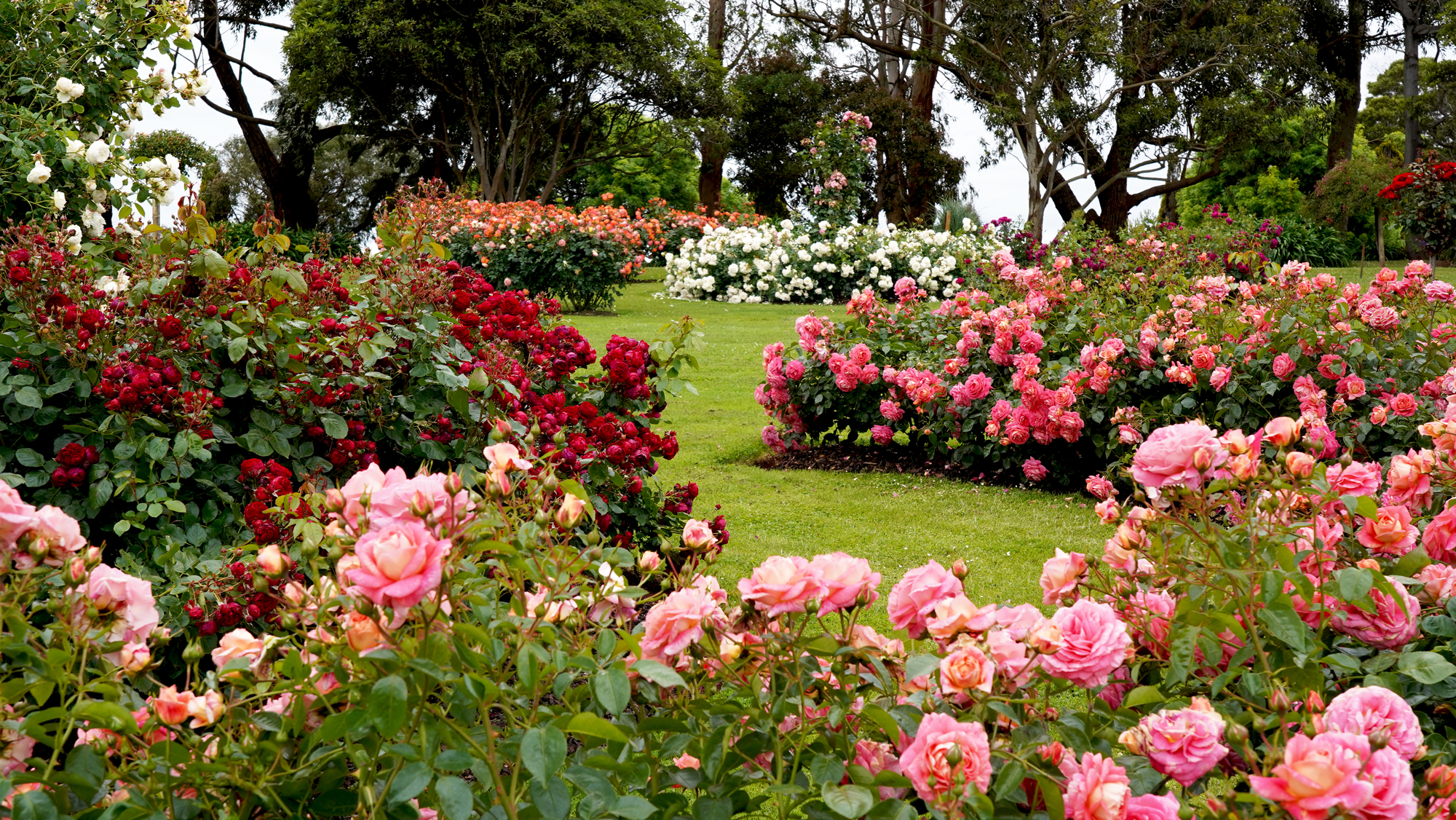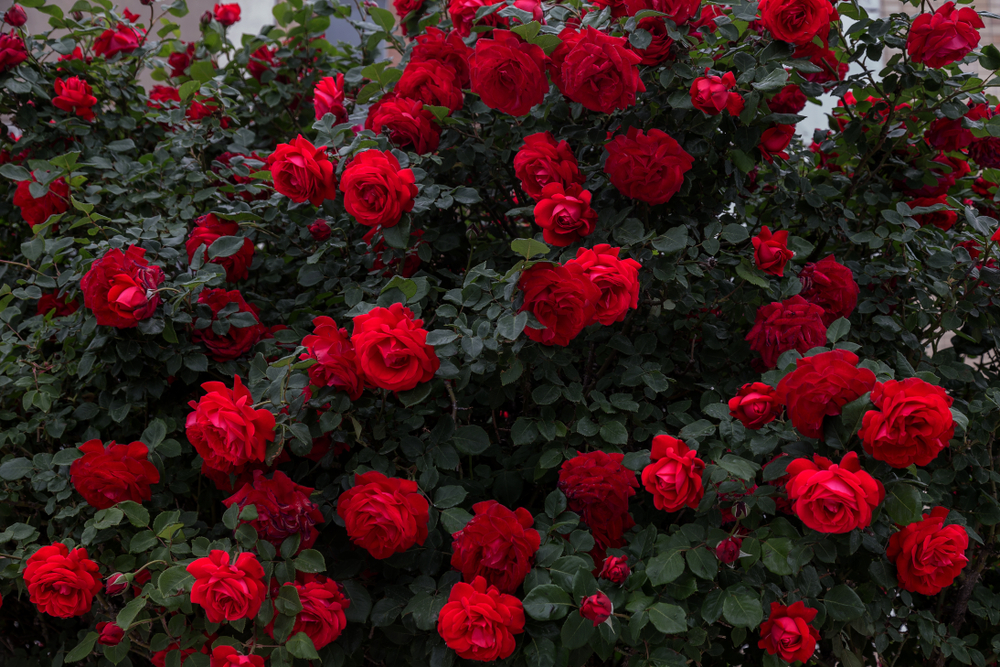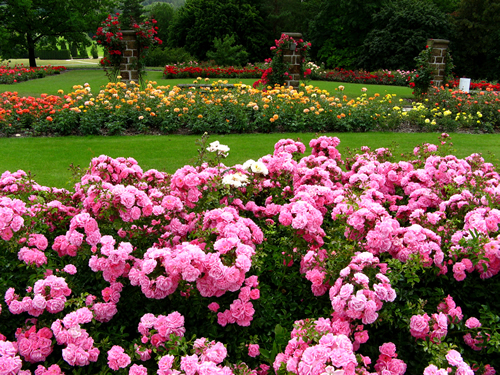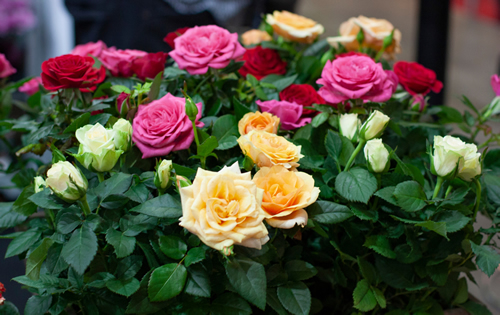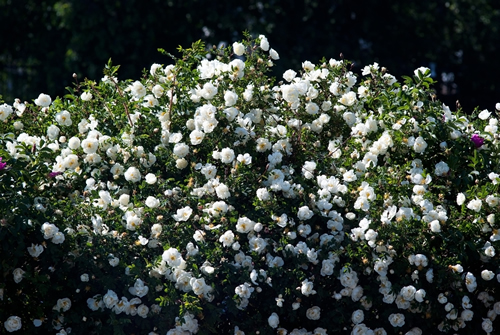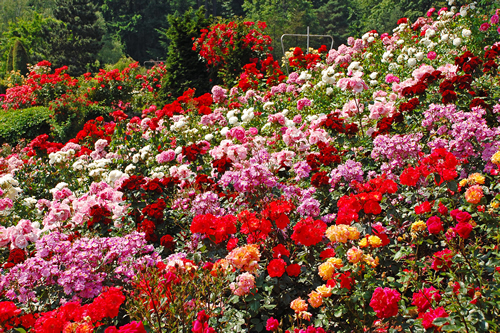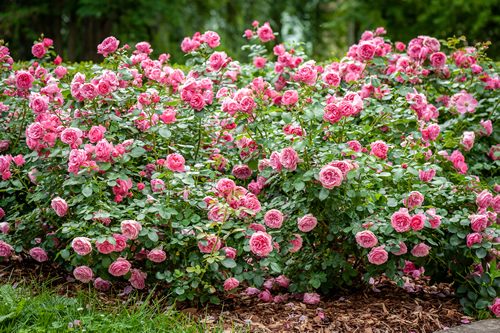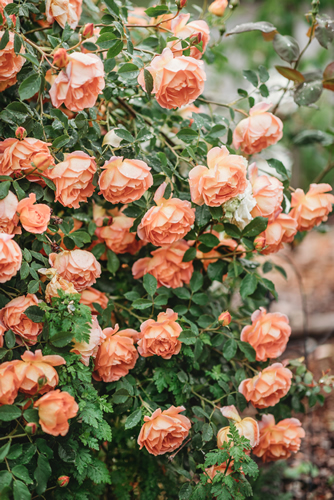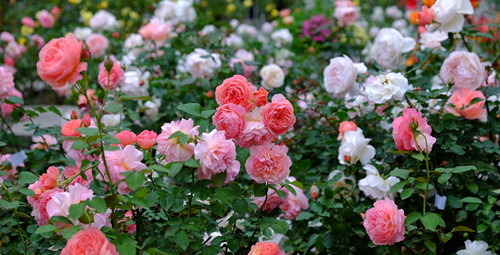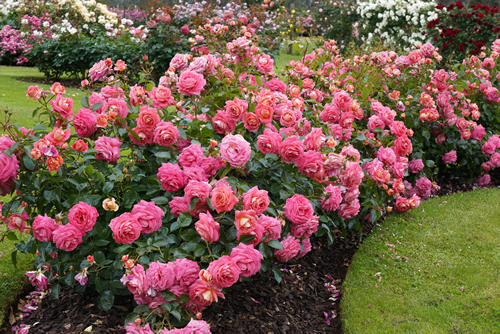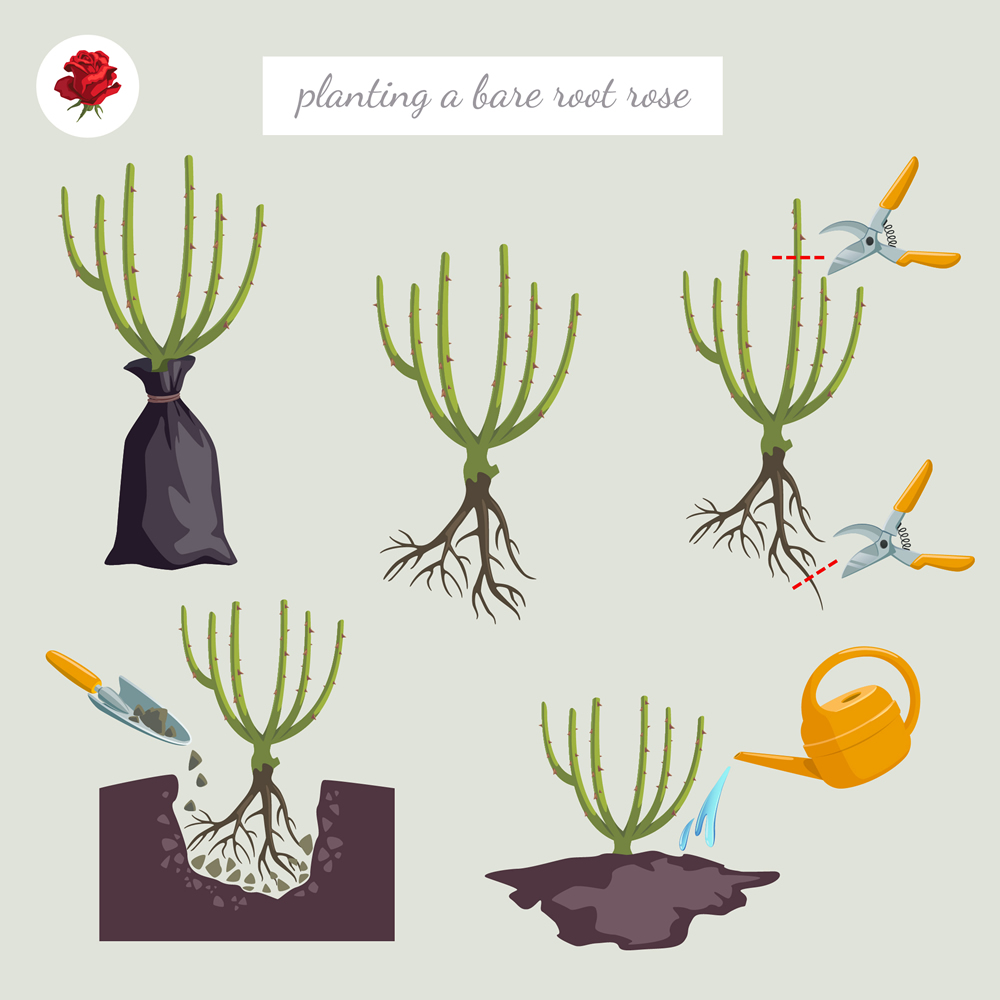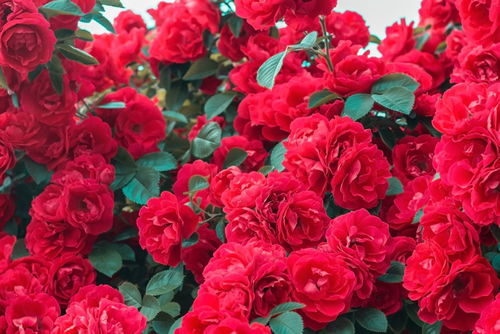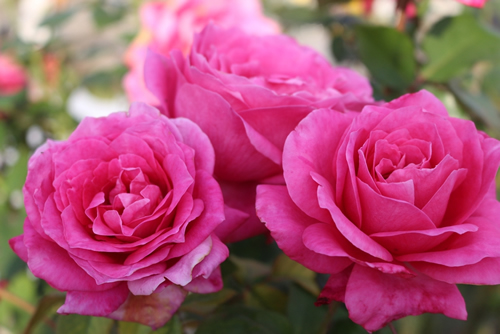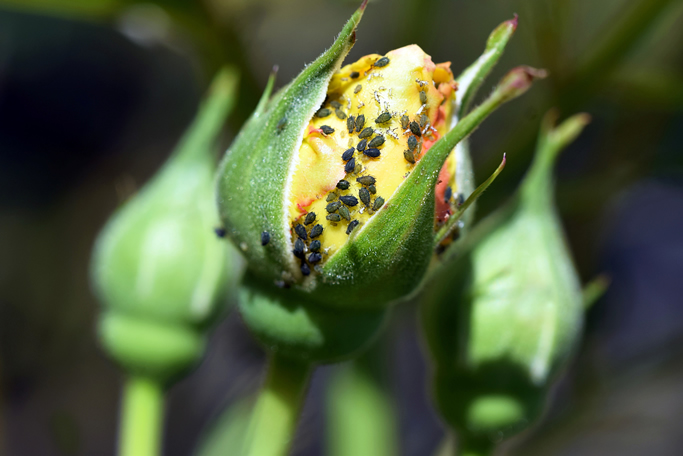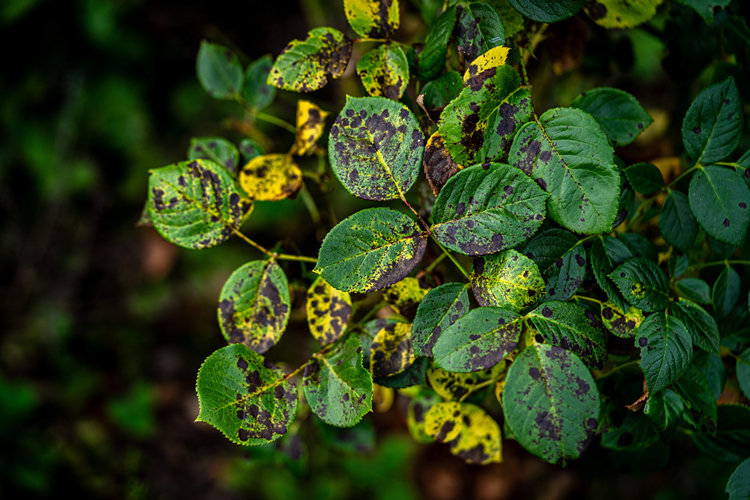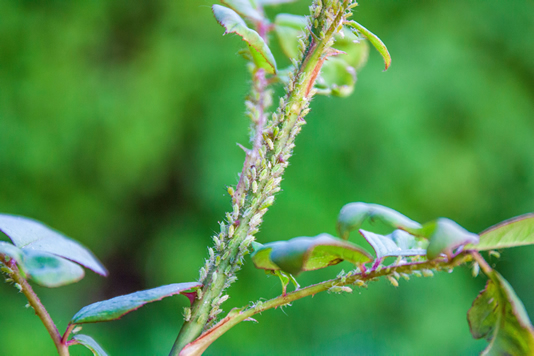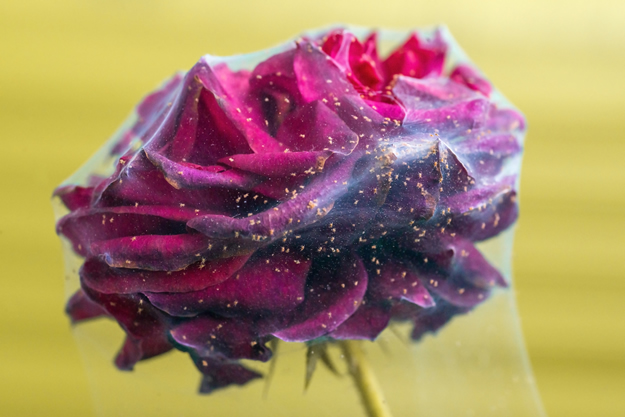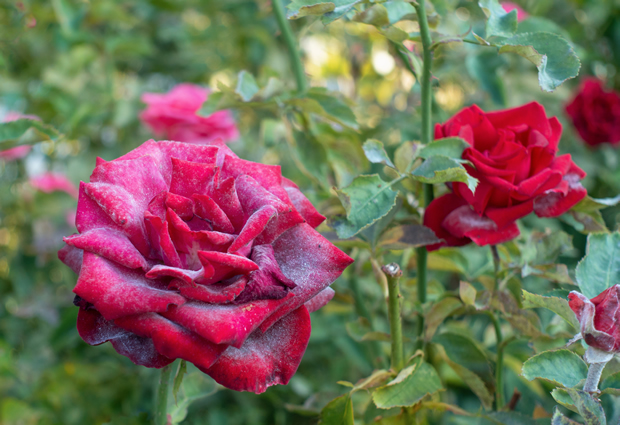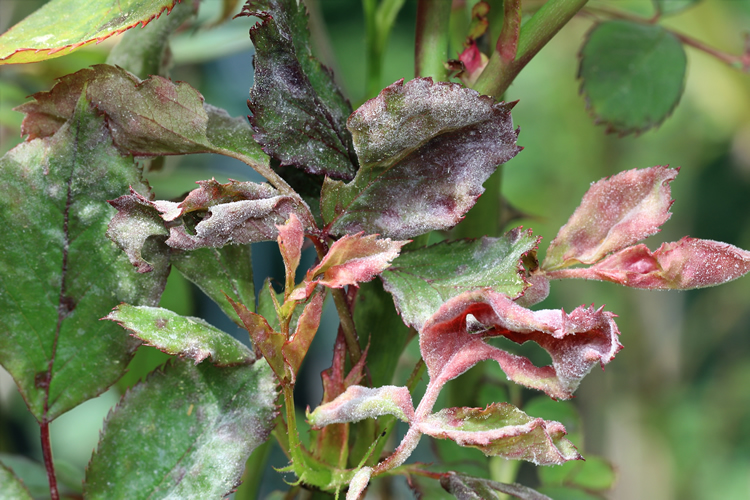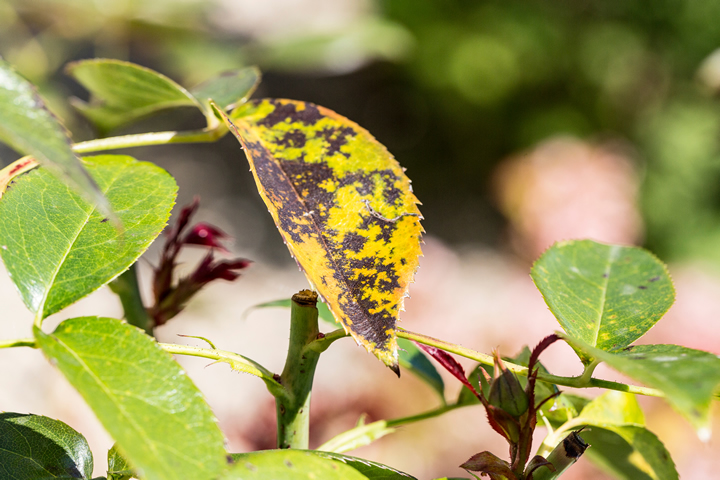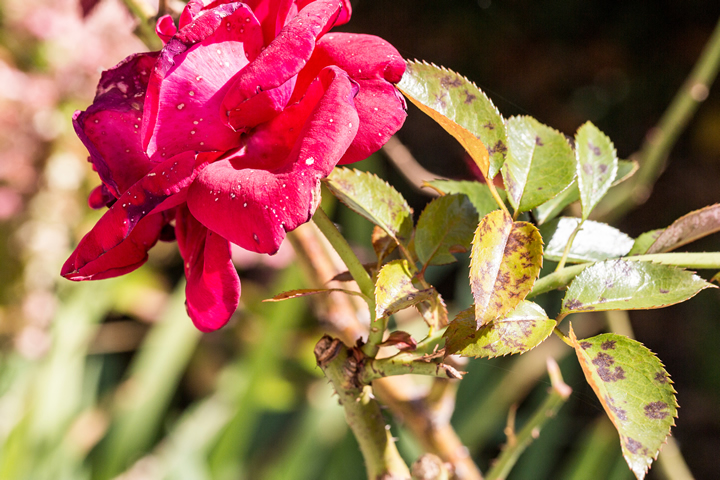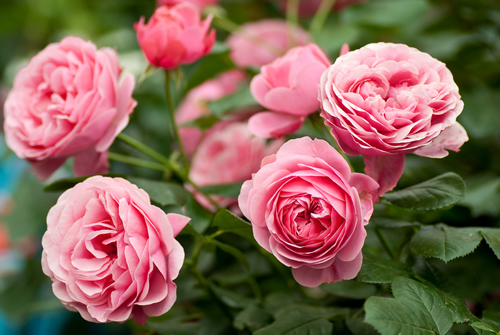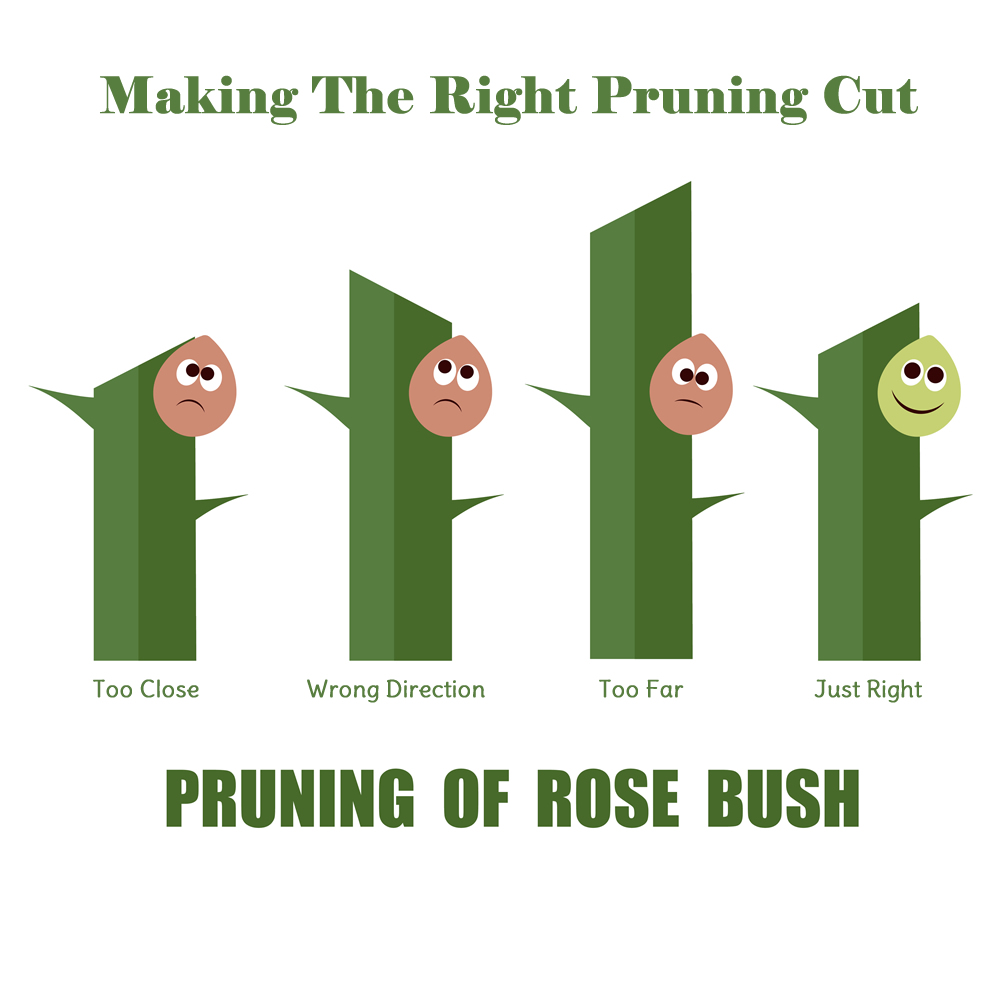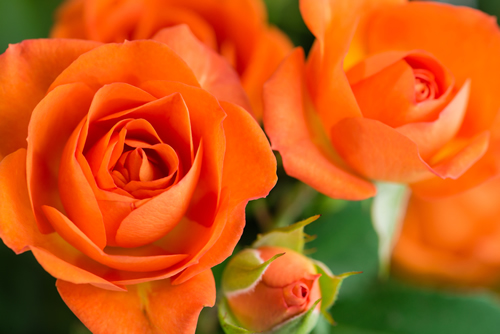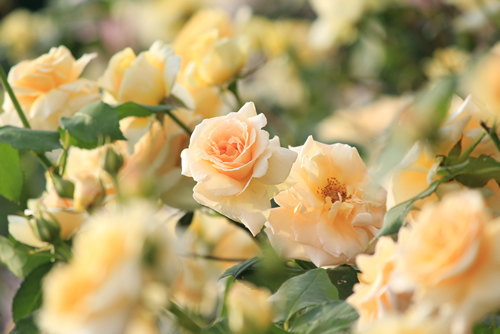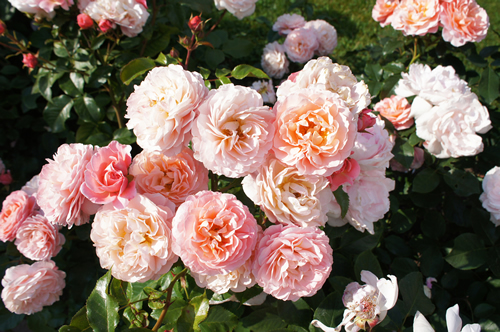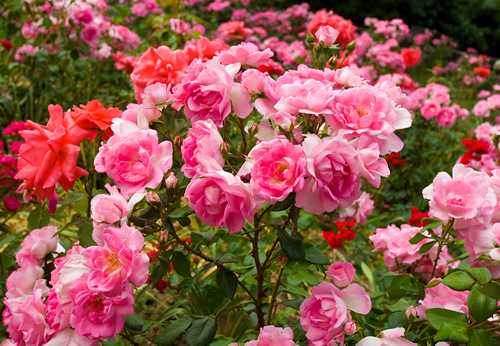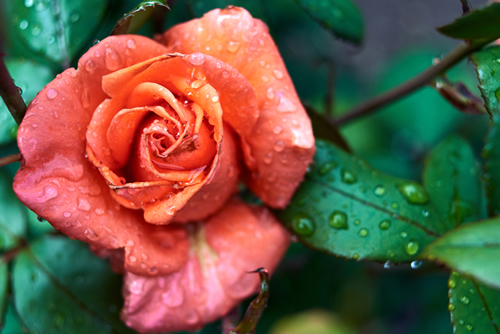How and When to Prune Rose Bushes
A Complete Guide to Planting and Caring for Rose Bushes
If you're a gardener looking for a beautiful addition to your landscape, roses are an excellent choice. With their plentiful colours and fragrant blooms, rose bushes create stunning displays of colour that add a certain romantic elegance to any garden. Growing and caring for roses can be a rewarding experience – but only if approached correctly. That's why we've put together this complete guide to planting and caring for rose bushes so you can enjoy its beauty without worry or stress! From choosing the right type of rose bush to understanding how best to care for them throughout their growing season, everything you need will be covered in this guide. So let's dig into it!
The rose, renowned for its beauty and fragrance, has a rich history and holds a special place in the United Kingdom's heart. Its popularity is entwined with cultural, historical, and economic factors.
The rose has been a symbol of love, beauty, war, and politics throughout human history. In the UK, it gained prominence during the Wars of the Roses in the 15th century, where the red rose symbolized the House of Lancaster and the white rose represented the House of York. The eventual merging of these two houses led to the creation of the Tudor Rose, a two-tone rose that became a powerful national symbol.
Belonging to the genus Rosa in the family Rosaceae, roses are woody perennial flowering plants. They come in numerous colors, each carrying different symbolic meanings. For example, red roses represent love and respect, yellow roses symbolize friendship, and white roses signify purity.
Today, the rose continues to be England's national flower, symbolizing grace, love, and resilience. The English rose, a term used to describe both a category of roses and an archetype of English womanhood, is deeply ingrained in British culture.
Regional variations exist, such as the Burnet rose in Scotland and the Tudor rose in England. The Burnet rose, also known as the Scotch rose, is a white, five-petaled flower prominent in Scottish heraldry. The Tudor rose, combining a red outer layer and a white center, remains a distinctive emblem of England.
The cultivation and sale of roses contribute significantly to the UK's floriculture industry. According to a report by IBISWorld, the flower and plant growing industry in the UK, of which roses are a part, is worth £1.3 billion. Though specific figures for roses are hard to find, their popularity for occasions like Valentine's Day and Mother's Day undoubtedly contributes substantially to this figure.
In conclusion, the rose's popularity in the UK stems from its historical significance, symbolic power, aesthetic appeal, and economic value. Its status as the national flower is a testament to its enduring relevance in British society.
The History of Rose Bushes in the UK - Is the English Rose actually British?
The rose is one of the most iconic flowers in history, and it has played a significant role in British culture for centuries. However, the question remains: is the English rose actually British? While the answer may seem clear-cut, the history of rose bushes in the UK is much more complex than one might think.
The popularity of the rose can be traced back to the Roman era when they introduced it to Britain. In ancient civilizations, roses were surrounded by both law and myth. In Rome, for instance, anything said "under the rose" (sub rosa) was considered secret, leading to a law that a rose should be hung from the ceiling at confidential meetings.
In mythology, the rose often symbolizes love and beauty. Greek mythology tells us that it was Aphrodite, the goddess of love, who gave the rose its name. Roman mythology tells a similar story, with Venus being the goddess associated with this beautiful flower. Even in Chinese mythology, roses are depicted as symbols of eternal love.
Over the years, many different varieties of rose bushes were brought over from various countries and bred with native species to create the English rose we know today.
So, while the English rose may not be purely British, its rich history and cultural significance in the UK cannot be denied.
The history of the rose in the UK
The rose has a long and storied history in the UK, with its roots intertwined with royalty, religion, and culture. The first recorded use of the rose as a royal symbol in England dates back to 1236 when Eleanor of Provence, who married Henry III, took the white rose as her symbol.In the Christian tradition, the rose was representative of the Virgin Mary, further embedding its symbolic significance in English culture.
Arguably, the most well-known association of the rose in England is with the House of Tudor. The Tudor rose, which combines the red rose of Lancaster and the white rose of York, became the floral heraldic emblem of England following the Wars of the Roses. These wars were a series of civil conflicts fought for control of the throne in the 15th century.
The rose's symbolism extended beyond politics and religion, with the flower also being a symbol of silence and secrecy in ancient Greece and Rome, a tradition that made its way to the UK.
Today, the rose continues to hold a prominent place in UK culture. The English Rose, specifically the red Tudor rose, remains the national flower of England.
In conclusion, the history of the rose in the UK is rich and multifaceted. From royal emblems to religious symbols, the rose's significance has evolved over time, mirroring the country's own historical and cultural changes.
Today, the rose continues to be England's national flower, symbolizing grace, love, and resilience. The English rose, a term used to describe both a category of roses and an archetype of English womanhood, is deeply ingrained in British culture.
Regional variations exist, such as the Burnet rose in Scotland and the Tudor rose in England. The Burnet rose, also known as the Scotch rose, is a white, five-petaled flower prominent in Scottish heraldry. The Tudor rose, combining a red outer layer and a white center, remains a distinctive emblem of England.
The cultivation and sale of roses contribute significantly to the UK's floriculture industry. According to a report by IBISWorld, the flower and plant growing industry in the UK, of which roses are a part, is worth £1.3 billion. Though specific figures for roses are hard to find, their popularity for occasions like Valentine's Day and Mother's Day undoubtedly contributes substantially to this figure.
Introducing Rose Bushes - Different Types and Varieties
Rose bushes are some of the most iconic and beloved plants in the world. They come in different types and varieties, each one with its unique features and characteristics. For instance, hybrid tea roses have long stems with one bloom per stem, while floribunda roses have clusters of blooms on each stem. Climbing roses, as the name suggests, are perfect for training to climb up trellises or walls.
Meanwhile, miniature rose bushes are ideal for container gardening and adding a pop of colour to balconies and patios. No matter which type you choose, caring for rose bushes can be a rewarding and satisfying experience. With the right care and attention, these stunning plants can bloom beautifully for years to come.
Common Types and Varieties of Rose Bushes in the UK
Roses are one of the most popular flowering plants in the UK. Here's a list of the most common types and varieties of rose bushes found in the UK, along with some care tips for each:
Hybrid Tea Roses
Hybrid Tea Roses are some of the most popular modern roses in the UK. They are known for their large, elegant blooms and long stems. They come in a wide range of colors and can be grown as shrubs or climbers.
Popular Varieties: Peace, Queen Elizabeth, Mister Lincoln
Planting and Care Tips: Plant in well-drained soil and in a spot with plenty of sunlight. Prune back in the early spring to promote new growth.
Floribunda Roses
Floribunda Roses are a cross between Hybrid Teas and Polyantha Roses. They are known for their clusters of blooms and hardiness. They come in a wide range of colors and can be grown as shrubs or climbers.
Popular Varieties: Iceberg, Sexy Rexy, Europeana
Planting and Care Tips: Plant in well-drained soil and in a spot with plenty of sunlight. Prune back in the early spring to promote new growth.
Shrub Roses
Shrub Roses are known for their hardiness and disease resistance. They come in a range of sizes and bloom types, including single, semi-double, and double blooms.
Popular Varieties: English Miss, Constance Spry, Bonica
Planting and Care Tips: Plant in well-drained soil and in a spot with plenty of sunlight. Prune back in the early spring to promote new growth.
Climbing Roses
Climbing Roses are perfect for adding height and a touch of elegance to any garden. They can be trained to grow on trellises, walls, and pergolas.Popular Varieties: New Dawn, Albertine, Paul's Scarlet Climber
Planting and Care Tips: Plant in well-drained soil and in a spot with plenty of sunlight. Prune in the early spring to promote new growth. Train the canes horizontally to promote more blooms.
Heritage Roses
Heritage Roses refer to any roses that were in cultivation before 1867. They are known for their unique and old-fashioned blooms, as well as their hardiness.
Popular Varieties: Madame Hardy, Rosa Mundi, Moss Rose
Planting and Care Tips: Plant in well-drained soil and in a spot with plenty of sunlight. Prune back in the early spring to promote new growth.
Conclusion | No matter which type or variety of rose you choose to plant, they all require well-drained soil, plenty of sunlight, and regular watering and care. By providing the proper care for each type of rose, you can enjoy their beauty and fragrance in your garden for years to come.
Planting and Positioning Your Rose Bushes
Planting and positioning your rose bushes can be a tricky art to master, but it is a rewarding one nonetheless. One of the most important factors to consider is the amount of sunlight your roses will be receiving. Roses require a minimum of six hours of direct sunlight per day, so be sure to choose a spot that gets plenty of sunshine.
Additionally, it's important to ensure that the soil is well-draining and rich in nutrients. With adequate sunlight, good soil, and proper planting techniques, your rose bushes are sure to thrive and will provide you with beautiful blooms to enjoy for years to come.
Creating the Perfect Soil for Your Roses
Do you want your rose garden to be the envy of the neighbourhood? The key to having beautiful, healthy roses is to start with the perfect soil. Roses have specific needs when it comes to soil – it should be well-draining yet still able to hold moisture, and nutrient-rich without being too dense. To create the perfect soil for your roses, start by choosing a good quality potting mix or garden soil. Then, add organic matter such as compost or well-rotted manure to improve drainage and fertility. Don't forget to test the pH level of your soil and make adjustments if necessary. With the right soil, your roses will thrive and bloom in abundance.
Adding organic matter to the soil is an essential step to prepare the planting site for roses. Organic matter enriches the soil, improves soil structure, and helps retain moisture. Here are some organic amendments you can use:
- Compost: Compost is a mixture of decomposed organic matter that is rich in nutrients. It helps improve soil fertility, structure, and water-holding capacity. Spread a layer of compost over the soil and mix it into the top few inches of soil.
- Well-rotted Manure: Manure is a good source of organic matter and nutrients. Make sure the manure is well-rotted (aged at least six months to a year) to prevent burning the roots. Add a 2-4 inch layer of well-rotted manure over the soil and mix it into the top few inches of soil.
- Leaf Mold: Leaf mold is a type of compost made up of decomposed leaves. It helps improve soil structure and water-holding capacity. Spread a layer of leaf mold over the soil and mix it into the top few inches of soil.
- Peat Moss: Peat moss is an acidic, fibrous material that helps improve soil structure and water-holding capacity. Mix peat moss with the soil in a 3:1 ratio (3 parts soil to 1 part peat moss) to improve drainage.
- Perlite and Vermiculite: Perlite and vermiculite are lightweight materials that help improve soil structure, aeration, and drainage. Add a 1-2 inch layer of perlite or vermiculite over the soil and mix it into the top few inches of soil.
In addition to adding organic matter, you can also add some bone meal to the soil, which is a good source of phosphorus that helps root development. Follow the instructions on the package for the appropriate amount of bone meal to add to the soil. Mixing the bone meal with the soil will help ensure that the roots have access to the nutrients they need to grow and prosper.
By amending the soil with organic matter and bone meal, you will be providing the necessary nutrients to the soil, which will help your roses grow strong and healthy.
Choosing and Applying Mulch for Your Rose Bushes
Choosing and applying the right mulch for your rose bushes can seem like a daunting task, especially for those new to gardening. However, with a little guidance, it can be a simple and rewarding process. When selecting a mulch, consider the needs of your rose bushes. Organic mulches, such as wood chips or shredded leaves, can provide important nutrients as they decompose. Alternatively, inorganic mulches, like stones or rubber chips, can offer longer-lasting weed control and aesthetic appeal.
It's important to apply the mulch correctly, ensuring a consistent layer of 2-4 inches around the base of the rose bush, being careful not to cover the stem or crown. With these tips in mind, choosing and applying mulch for your rose bushes will not only benefit the plants but also add beauty and longevity to your garden.
Best Types of Mulch for Your Rose Bushes
Mulching your rose bushes is an important step in maintaining healthy plants. Mulch helps to conserve moisture, suppress weeds, regulate soil temperature, and prevent soil erosion. Here are some of the best types of mulch for your rose bushes:
-
1. Organic Mulch
Organic mulch is made from natural materials that decompose over time and add nutrients to the soil. Some of the most popular organic mulches for roses are:
- Wood Chips: Wood chips are a popular choice for mulching roses as they are easy to apply, have a slow decomposition rate, and provide good insulation for the soil. They help to maintain moisture levels and suppress weed growth.
- Shredded Leaves: Shredded leaves are a great natural mulch for roses that provide nutrients as they decompose. They have a fine texture, which makes them excellent at suppressing weeds and retaining moisture in the soil.
- Straw: Straw is an excellent mulch for roses as it is lightweight, easy to apply, and breaks down slowly. It also helps to maintain soil moisture and regulate temperature.
- Grass Clippings: Grass clippings are a good choice for mulching roses as they are readily available, free, and quick to decompose. They help to add nutrients to the soil, but make sure to avoid using clippings from lawns that have been treated with pesticides or herbicides.
-
2. Inorganic Mulch
Inorganic mulch is made from synthetic materials that do not decompose and can last for several years. Some of the best inorganic mulches for roses are:
- Gravel or Pebbles: Gravel or pebbles are a great mulch for roses as they are long-lasting, do not compact, and can add aesthetic value to your landscaping. They also help to improve soil drainage, which is important for maintaining healthy plants.
- Plastic: Plastic mulch is a good choice for controlling weeds and conserving moisture in the soil. It helps to maintain a consistent soil temperature, which is beneficial for roses. However, it is not a sustainable choice and can harm the soil microbiome over time.
- Rubber: Rubber mulch is becoming popular for its durability and low maintenance. It is made from recycled tires and can last for several years. However, it can heat up in the sun and become toxic to plants.
In conclusion, organic mulches are the best choice for your rose bushes as they provide nutrients to the soil and promote healthy microbial activity. You can choose from a variety of organic materials, including wood chips, shredded leaves, straw, or grass clippings. However, if you prefer an inorganic mulch, gravel or pebbles are a good choice for improving soil drainage and keeping the soil temperature consistent.
What is the best month to plant Roses?
Roses are one of the most beloved flowers around the world, and many gardeners are always on the lookout for the best time to plant them. While there are many factors to consider, the best month to plant roses is typically in the early spring, preferably from late March to early April.
At this time, the soil is warm and moist enough to provide the roses with the necessary nutrients and moisture for growth. Moreover, planting during this season also ensures that your roses will have enough time to establish strong roots before the harsher weather conditions of summer and winter hit.
With a little attention and care, your rose bushes will continue to bloom and bring joy to your garden for years to come.
What should you not plant around Roses?
Roses are one of the most beautiful and fragrant flowers that can brighten up any garden. However, to ensure their growth and health, it is important to be careful about what you plant around them. One of the things to avoid planting around roses is trees with shallow roots, such as willows, silver maples, or poplars.
These trees compete with roses for nutrients and water, which can stunt their growth and damage their roots. Additionally, it is recommended to avoid planting vegetables like garlic and onions around roses, as they release chemicals that can be harmful to the flower. By being mindful of what you plant around your rose beds, you can help keep them healthy and thriving for years to come.
How to Propagate a Rose Bush from a Cutting
Creating new rose bushes from cuttings is an exciting and rewarding process for any gardener. To begin, choose a healthy rose bush with strong stems and fresh growth. Using sharp and clean pruning shears, take a cutting of the stem that is between six to eight inches long. Strip the leaves from the bottom half of the stem and dip the cut end into rooting hormone to encourage root growth. Place the cutting in a pot with moist soil and cover with a clear plastic bag to create a humid environment. After several weeks, roots should begin to form and new growth should appear. Soon, your new rose bush will be ready to transplant into your garden, bringing a burst of colour and fragrance to your outdoor space.
How to Propagate a Rose Bush from a Softwood Cutting
Propagating roses from softwood cuttings is a great way to create new plants from an existing rose bush. Follow these simple steps to propagate a rose bush from a softwood cutting.
-
Step 1: Gather Materials
- Healthy rose bush
- Clean, sharp garden shears
- Rooting hormone powder
- Sterilized potting soil
- Small pots or containers
- Clear plastic bags or plastic wrap
- Watering can
- Spray bottle
Step 2: Select and Cut the Softwood Stem
Select a healthy stem from your rose bush that hasn't bloomed yet. Make sure the stem is green, flexible, and at least 6 inches long. Cut the stem at a 45-degree angle using clean, sharp garden shears. Make sure to cut just below a leaf node.
-
Step 3: Prepare the Cutting
Remove the leaves from the bottom 2-3 inches of the stem, leaving 2-3 leaves at the top. Dip the cut end of the stem into rooting hormone powder, tapping off any excess.
-
Step 4: Plant the Cutting
Fill a small pot or container with sterilized potting soil. Make a hole in the soil using your finger or a pencil and insert the cutting about 2 inches deep. Gently press the soil around the stem to hold it in place.
-
Step 5: Water and Cover
Water the soil thoroughly and allow it to drain. Cover the pot or container with a clear plastic bag or plastic wrap to create a mini greenhouse. This will provide the cutting with the humidity levels it needs to root.
-
Step 6: Place the Container in a Bright Location
Place the container in a bright location out of direct sunlight. Avoid areas that are too hot or drafty. The roots should start to grow within a few weeks.
-
Step 7: Maintain the Cutting
Check the soil moisture level regularly to ensure that it remains moist but not waterlogged. Use a spray bottle to mist the leaves to maintain humidity levels. Once the cutting has rooted and grown new leaves, remove the plastic cover and gradually expose it to more light.
-
Step 8: Transplant the Cutting
Once the cutting has grown to a substantial size, transplant it to a larger pot or directly to the garden. Make sure to plant it in well-draining soil and in a location that has adequate sunlight.
By following these steps, you can easily propagate a new rose bush from an existing one and enjoy the beauty of roses in your garden. The softwood cutting method is an easy and successful way to propagate new plants, so don't be afraid to give it a try!
Can you Grow a Rose from Seed?
Growing plants from seeds is a rewarding experience that anyone can do, no matter how much experience they have. With just a little bit of patience and care, you can watch your tiny seedling grow into a thriving plant.
Whether you're starting a garden or just trying to grow a few plants in your home, seeds are a great place to start.
Not only are they inexpensive and widely available, but they also offer endless possibilities for diversity in your garden. So take the leap and give seed starting a chance; you never know what beautiful and unique plants you may end up with.
How to Successfully Grow a Rose Plant from Seed
Growing roses from seed can be a rewarding and fulfilling process for any gardener. Here is a detailed guide to help you grow a rose plant from seed successfully.
Requirements for Growing Roses
- Sunlight: Roses require at least six hours of direct sunlight daily to grow and bloom. Choose a spot in your garden that receives enough sunlight.
- Soil: Rose plants thrive in well-draining soil, rich in organic matter.
- Water: Regular watering is important for the health of rose plants.
- Fertilizer: Use a balanced fertilizer specifically formulated for roses for better growth and blooming.
Planting the Seeds
Choose the seeds of a rose variety that you would like to grow. You can purchase seeds from a gardening store or collect them from an established rose plant by waiting until the flowers fade away and the seed heads appear.
- Fill individual seedling pots with potting soil and moisten with water.
- Plant the seeds about 1/8 inch deep in the soil.
- Cover the pots with plastic wrap or a clear plastic lid to help retain moisture.
- Place the pots in a warm and well-lit area, preferably under grow lights or in a greenhouse.
- Keep the soil consistently moist but avoid over-watering, as this can lead to damping-off disease.
Propagation
Rose seeds are often slow to germinate and can take up to one month or even longer to start growing. The germination time may vary depending on the variety and the conditions.
Choose a warm location that is around 70-75 degrees Fahrenheit for the seedlings.
Once the seedlings have grown a few inches tall, transplant them into larger pots.
Once the plants have been established, you can gradually begin to acclimate them to the outdoor conditions by exposing them to the sun and wind for a few hours a day.
Common Problems and Solutions
- Damping-off disease: This fungal disease can occur when the soil is kept too wet. To prevent this, avoid over-watering and maintain proper drainage of the pots.
- Fungal diseases: Ensure good air circulation around the plants and remove any infected foliage immediately to prevent the spread of diseases.
- Pests: Aphids, Thrips, and Spider Mites are common pests that can attack rose plants. Use insecticidal soap spray or neem oil to control the pests.
Maintaining Healthy Rose Plants
- Water: Water your rose plants regularly and deeply; the plant should never be allowed to dry out completely.
- Fertilizer: Fertilize your rose plants once a month during the growing season with a balanced fertilizer formulated for roses.
- Prune: Prune your roses regularly to maintain their shape and health, and remove any dead, damaged, or diseased wood.
With the right conditions and care, growing a rose plant from seed can be a fulfilling and rewarding experience. Patience and dedication are key to successfully growing beautiful rose plants from seeds.
How to Plant Roses in the Ground
Roses are a timeless beauty that can add elegance and charm to any garden. Planting roses in the ground can be a bit intimidating for some, but with a little care and attention, you can successfully grow a thriving rose garden. Before you start planting, choose an area with good drainage and plenty of sunlight. Make sure to dig a hole big enough for the root ball and mix in some compost or fertilizer to keep the soil nutrient-rich. Plant the rose so that the root ball is covered with soil and water it well. Mulching around the base of the plant can help retain moisture and keep weeds at bay. With regular watering and pruning, your rose garden will soon be the envy of all your neighbors.
How to Plant Roses in the Ground
Planting roses in the ground is a great way to beautify your garden and add natural fragrance to your outdoor space. Here are the steps to plant roses in the ground:
-
Step 1: Choose the Right Spot
Choose a location that gets at least 6 hours of direct sunlight per day. Your roses will also need well-draining soil that is rich in nutrients. Avoid planting roses in low-lying areas or where water tends to pool.
-
Step 2: Prepare the Soil
Remove any debris, rocks, or weeds from the planting site. Loosen the soil by using a garden fork or tiller, and mix in organic matter such as compost or aged manure. This will improve soil structure and provide essential nutrients to your plants.
-
Step 3: Dig a Hole
Dig a hole that is twice the diameter of the root ball on your rose plant and deep enough to accommodate its roots. Make sure the hole is wide enough to provide space for the roots to spread out.
-
Step 4: Add Fertilizer
Add organic fertilizer to the soil to provide a good source of nutrients for your plants. You can use a balanced fertilizer that is formulated for roses or add aged manure to the soil.
-
Step 5: Soak the Roots
Soak the roots of your rose plant in water for at least an hour before planting. This will help to prevent transplant shock and promote healthy growth.
-
Step 6: Plant the Rose
Place the rose plant in the hole and ensure it is at the same depth as it was in its original container. Fill the hole with soil and gently press around the base of the plant to remove air pockets.
-
Step 7: Water and Mulch
Water your plant thoroughly and add a layer of mulch around the base of the plant to help retain moisture and suppress weed growth. Ensure that the mulch is not in contact with the stems of your rose plant as this may cause damage.
-
Step 8: Maintain Your Plants
Make sure to water your plants regularly, ensuring that the soil is moist but not waterlogged. Fertilize your plants regularly during the growing season and prune them once a year to promote healthy growth.
By following these steps, you can successfully plant and grow your own beautiful rose bushes. With proper care and attention, your rose plants will reward you with vibrant colors and sweet fragrances.
How to Grow and Maintain Rose Bush in Pots or Containers
How to Grow Rose Bushes in Pots or Containers
There's nothing quite like the beauty and fragrance of a blooming rose, and you don't need a sprawling garden to enjoy them. Growing roses in pots or containers can be just as rewarding and you might even find it easier to care for them this way. The key to success lies in selecting the right container, soil, and location for your rose bushes. A deep, wide pot with good drainage and nutrient-rich soil will provide plenty of growing space for your roses, while a sunny spot on your patio or balcony will ensure they get the light they need to thrive. With a little bit of patience, attention, and care, you can have a vibrant and flowery display of rose bushes all season long.
Growing roses in pots or containers is a great way to enjoy these beautiful and fragrant flowers even if you have limited garden space. Roses are an excellent choice for container gardening, as they are compact and easy to care for. Here is a guide on how to grow and maintain rose bushes in pots or containers.
Choosing the Right Container
Choosing the right container is important for the health and growth of your [Rose Variety] rose bush. It should be large enough to accommodate the root ball of the plant, with extra space for growth. A container that is at least 15 inches in diameter and 15 inches deep is recommended for this particular plant. Make sure the container has drainage holes to prevent waterlogging.
Soil and Fertilizer Requirements
Use high-quality potting soil that is formulated for container gardening. The soil should be well-draining and rich in organic matter. You can also mix in some perlite or vermiculite to aid in drainage.
Fertilize your rose bush once a month during the growing season with a balanced fertilizer. Use a fertilizer that is specifically formulated for roses. Follow the package instructions carefully to avoid overfertilization, which can damage the plant.
Watering Schedule
Water your rose bush regularly to keep the soil moist but not waterlogged. Check the moisture level of the soil by sticking your finger into the soil up to the first knuckle. If the soil feels dry, it's time to water. Water slowly and deeply, making sure the water reaches the root ball of the plant. Avoid getting water on the leaves of the plant, which can promote disease.
Pruning Techniques
Pruning is important for maintaining the health and shape of your rose bush. Prune the plant in early spring before new growth appears by removing any dead, diseased, or damaged wood. Cut back the remaining canes by one-third to one-half of their length to promote new growth and flowering.
Throughout the growing season, deadhead spent blooms regularly to promote new growth and encourage more blooms. Remove any dead, damaged, or diseased foliage and canes as needed.
Dealing with Bugs and Pests
Container gardening can be especially prone to bug and pest problems, so it's important to monitor your [Rose Variety] rose bush regularly for signs of infestation. Common pests that may affect roses include Aphids, Spider Mites, and Thrips. If you notice any sign of infestation, use an insecticidal soap or spray to control the problem.
Best Practices for Rose Bush Care
- Water your rose bush at the base, using a soaker hose or watering can.
- Fertilize your plant regularly with a slow-release fertilizer that's specifically formulated for roses.
- Prune your plant regularly to remove dead, damaged, and diseased wood. This will improve the plant’s health and shape.
- Provide good air circulation
Positioning Your Container
Place your container or pot in a location with at least six hours of direct sunlight per day. Rose bushes prefer full sun but can also tolerate partial shade. Avoid placing the container in windy locations, as strong winds can damage the plant.
Here's a list of the best rose varieties to be grown in pots or containers:
- Flower Carpet Roses: These are easy to grow, low-maintenance, and disease-resistant roses. They have a long blooming season and come in a variety of colours.
- Miniature Roses: These are perfect for small containers and have a compact growth habit. They bloom in clusters and come in a range of colours.
- Patio Roses: These roses have a small growth habit and are ideal for small containers. They have a long blooming season and come in a variety of colours.
- Knock Out Roses: These are one of the most popular roses for container gardening. They are disease-resistant, bloom in a range of colours, and have a long blooming season.
- David Austin English Roses: These roses have a classic and elegant look. They require careful attention but are worth the effort for their beautiful blooms and exquisite fragrance.
By choosing the right rose variety, you can enjoy the beauty and fragrance of roses even if you have limited garden space. Remember to provide ample room for the root ball, use high-quality potting soil and fertilizer, water regularly, and prune as needed to ensure the health and beauty of your container-grown roses.
By following these guidelines, you can grow and maintain a healthy and beautiful Rose Variety rose bush in a pot or container. Remember to provide ample room for the root ball, use high-quality potting soil and fertilizer, water regularly, and prune as needed to promote new growth and flowering. With proper care and attention, your [Rose Variety] rose bush will thrive in its container and provide you with beautiful blooms throughout the growing season.
Comprehensive List of Pests and Diseases that Commonly Affect Rose Bushes
Roses are popular garden plants prized for their beauty and fragrance. However, they can be susceptible to a variety of pests and diseases, which can impact their health and appearance. Here is a comprehensive list of the most common pests and diseases that affect rose bushes, as well as treatment and prevention methods.
Common Rose Species and their Pests and Diseases
Hybrid Tea Roses
Blackspot: This fungal disease causes dark spots on leaves. Infected leaves eventually fall off, leaving bare stems. Blackspot thrives in humid conditions and can be harmful to the plant if not treated.
Pests
Aphids: These are small, soft-bodied insects that feed on plant sap. They can cause stunted growth and yellowing of leaves. They are usually found on the undersides of the leaves. Thrips: These are small, slender insects that feed on the flowers and leaves of the plant. They can cause distorted growth and browning of the petals.
Prevention and Treatment Remove any infected leaves or stems immediately. Clean up any debris around the plant. Use a fungicide spray or dust to treat the plant, such as sulfur or copper-based products. For Aphids and Thrips, use insecticidal soap spray or neem oil. Make sure to thoroughly coat the leaves and stems.
Floribunda Roses
Powdery Mildew: This fungal disease causes a powdery white coating on the leaves and stems. It can also cause leaf curl and distortion.
Pests
Spider Mites: These are tiny, eight-legged pests that feed on the undersides of leaves. They can cause discolouration and yellowing of leaves. Rose Curculios: The adult bugs feed on flowers, while the larvae bore into the stems and canes. The feeding damage can cause dieback.
Prevention and Treatment
Ensure good air circulation around the plant to prevent moisture buildup, which can encourage Powdery Mildew growth. Use a fungicide spray or dust to treat the plant. Sulfur and potassium bicarbonate are natural remedies for Powdery Mildew. For Spider Mites, use insecticidal soap spray or neem oil. You can also use a strong jet of water to knock off the mites. Adult rose curculios can be hand-picked and destroyed. The larvae can be controlled with insecticide sprays.
Knock Out Roses
Rose Rosette Disease: This is a viral disease that is spread by a tiny mite. It causes excessive branch growth, deformed flowers, and distorted leaves. Infected plants may eventually die.
Pests
Japanese Beetles: These pests feed on the foliage, blooms, and buds of the plant. They can cause severe damage if left untreated. Rose Slugs: These are the larvae of a sawfly and feed on the leaves of the plant. They can cause holes to appear in the leaves.
Prevention and Treatment
There is no cure for Rose Rosette Disease, and infected plants should be removed and destroyed to prevent the spread of the virus. Use an insecticide spray or dust to control Japanese Beetles. You can also use a trap or hand-pick them off the plant. For rose slugs, use an insecticidal soap spray or neem oil. You can also handpick and destroy the larvae.
Climbing Roses
Botrytis Blight: This fungal disease causes brown spots on petals and flowers and can also affect leaves.
Pests
scale insects: These pests are small and can usually be found on the stems and leaves of the plant. They suck sap from the plant and can cause yellowing of leaves and stunted growth. Rose Chafers: These pests feed on the flowers and leaves of the plant. They can cause extensive damage if not controlled.
Prevention and Treatment
Remove any infected areas of the plant immediately and clean up any debris. Use a fungicide spray or dust to treat the plant. Copper-based products are effective against Botrytis Blight. For scale insects, use an insecticidal soap spray or neem oil. You can also scrape them off the plant with a soft-bristled brush. For rose chafers, use an insecticide spray or handpick them off the plant.
How often should you water a Rose Bush?
When it comes to watering your beloved rose bush, you want to make sure you strike the right balance between keeping it hydrated and not drowning it in too much water. The key is to understand that the frequency of watering depends on several factors such as the type of soil, climate, and time of year. In general, you want to water your rose bush deeply once a week, but during hot and dry spells, you may need to increase frequency to twice a week. On the other hand, during cooler and damp weather, you may not need to water as frequently. Always keep an eye on the condition of the soil and the leaves of your rose bush as a good indication of when it needs a drink. By providing the right amount of water at the right time, you can ensure that your rose bush thrives and blooms brilliantly.
How often should you fertilize and what is the best fertilizer to use for a Rose Bush?
Roses are one of the most beautiful and popular flowers in the world. However, they require a bit of care to thrive, including the right amount of fertilizer. When it comes to fertilizing rose bushes, the frequency depends on the type of fertilizer you use. Generally, you should fertilize once a month during the growing season. As for the best fertilizer, it's recommended to use a slow-release granular fertilizer with an N-P-K ratio of around 10-10-10. This will provide your roses with the essential nutrients they need to produce healthy blooms and strong growth. With the right fertilization routine, your rose bush will be the talk of the neighborhood.
From introducing your rose bushes to learning how to best take care of them, this blog post has provided readers with an extensive overview of all topics related to Rose Bushes. You now know the different types and varieties, how to plant and position them, what soil is best for them, which mulch you should use and how often you should water and feed your roses. Not to mention knowing how to protect your roses from pests and diseases, when the best month is to plant them, as well as what not to plant around them. You’re also more informed on their history in the UK and have received tutorials on planting in the ground or potting and container arrangements. Lastly, you have been enlightened on propagation from a cutting or seed – it’s time for you to get busy planning those flower beds! May the blooms last for many seasons; happy gardening!
A Complete Guide to Pruning a Rose Bush in the UK
Do you have a thriving rose bush in your garden that needs to be properly pruned? Pruning of rose bushes is an important part of floral-care maintenance. This can help promote new growth, increase the beauty of your roses, remove dead or diseased parts and even maximize flowering potential! By taking the time to understand proper techniques you can have beautiful roses throughout the entire season. In this guide we will provide you with all the steps necessary for successful Rose Bush pruning in the United Kingdom’s climatic conditions so that you are able to achieve maximum results from your hard work. Read on for more information!
Identifying the best time of year to prune a rose bush in the UK
If you're a gardening enthusiast, you understand that pruning your plants is essential for their health and growth. When it comes to rose bushes, timing is everything. The best time of year to prune your rose bush in the UK is around late winter or early spring, just before the growing season begins. The reason for this is because the plant is dormant during this time, which means it is not actively growing, making it the ideal time for pruning. Pruning can help improve the overall appearance of the rose bush, promote new growth, and remove any diseased or damaged branches. Plan ahead and grab your pruning tools to ensure your rose bush blooms beautifully during the upcoming growing season.
Understanding basic pruning techniques for roses
Pruning your roses can make a significant difference in their health and overall appearance, but the process can be intimidating. Understanding basic pruning techniques can help you feel more confident and ensure that your roses thrive. First, you must determine the right time to prune your roses, which is typically in late winter or early spring. Next, assess the plant's needs and address any dead, diseased, or damaged stems first. Then, make clean cuts with sharp, clean tools while considering the desired shape and size of the plant. With practice and patience, you'll soon become an expert at pruning your beautiful roses.
Rose pruning is a crucial task that can enhance the health of your plants, stimulate blooms, and revive their beauty. Pruning not only helps maintain the structure of the plant but also removes any dead wood, diseased or damaged parts. Below are some best practices for pruning your roses:
When to prune roses:
The ideal time to prune your roses is in late winter or early spring, before the plant starts its growing season. However, some rose varieties that bloom on old wood may require pruning after flowering in summer.
Tools required:
- Pruning shears
- Loppers
- Gloves
- Disinfectant spray or wipes
Techniques for pruning roses:
- Deadheading: Removing spent blooms is essential to stimulate new growth and encourage more blooms. Deadhead just above the first set of healthy leaves.
- Shaping: This technique is used to maintain the rose plant's natural form. Trimming back any overgrown stems or canes will help achieve a desirable plant shape
- Thinning: Thinning involves removing entire stems or canes from the base of the plant. This technique is used to maximize airflow and sunlight to the interior of the plant, thus promoting healthy growth.
Steps to follow when pruning roses:
- Remove any dead, dying, or diseased wood using clean, sharp pruning shears or loppers. Cut the stems back to the healthy portion just above the bud.
- Use a sharp pair of pruning shears or loppers to trim the remaining canes or stems. Make your cuts at an angle to allow water to run off the cut.
- Ensure that you cut the stems above a healthy bud, at a 45-degree angle, to encourage healthy growth.
- If you encounter any crossing branches, cut them back to eliminate rubbing, which could cause injury.
- Cut the canes to half their size if you want a smaller plant. Otherwise, trim them down by a third.
- Clean and sterilize your tools with disinfectant spray or wipes to prevent the spread of diseases.
Tips for a healthy rose plant after pruning:
- Water the plant deeply to encourage new growth and prevent water stress.
- Apply a slow-release fertilizer to keep the plant healthy and nourished.
- Mulch the base of the plant to retain moisture and organic matter.
- Clean up and dispose of any removed plant material to prevent the spread of disease.
By following these best practices, you can ensure that your rose plants remain healthy and vibrant throughout the growing season. Pruning is an essential part of keeping your plants flourishing. Confidence, patience, and care will help you achieve an abundant bloom in the next season.
Deadheading Roses
Deadheading is the process of removing spent blooms from a rose plant. This technique is essential to stimulate new growth and encourage more blooms. Deadheading should be done regularly throughout the growing season to maximize the plant's blooming potential.
To deadhead a rose plant, follow these steps:
- Identify the spent bloom. Spent blooms are faded, wilted, and brown in colour.
- Follow the stem down to the first set of healthy leaves.
- Using clean and sharp pruning shears or scissors, cut just above the first set of healthy leaves.
- Cut at a 45-degree angle to promote new growth and prevent water from settling on the cut.
By deadheading regularly, you can encourage your rose plant to produce new blooms and maintain a healthy and vibrant appearance.
It's important to use clean and sharp tools to avoid damaging the plant and to prevent the spread of diseases. It's also a good idea to dispose of removed blooms and foliage in a bag or bucket to avoid the spread of disease.
In conclusion, deadheading roses is an essential task for promoting healthy growth and vibrant blooms. Regularly removing spent blooms will encourage new growth and keep your rose plants looking their best throughout the growing season.
Shaping Roses
Shaping is a pruning technique used to maintain the rose plant's natural form. Trimming back any overgrown stems or canes can help to achieve a desirable plant shape. This technique is typically done during the dormant season when the plant is not actively growing.
To shape a rose plant, follow these steps:
- Identify the stems or canes that are growing out of bounds or interfering with the plant's natural shape.
- Using clean and sharp pruning shears, cut back the selected stems or canes to just above an outward-facing bud or branch.
- Make the cut at a 45-degree angle to promote new growth and prevent water from settling on the cut.
- Remove any crossing or rubbing stems or canes.
- Step back and assess the plant's shape and repeat the process as necessary to achieve the desired shape.
It's important not to over-prune or remove too much of the plant at one time, as this may result in reduced blooms and poor growth. Always use clean and sharp tools to avoid damaging the plant and to prevent the spread of diseases.
By shaping your rose plant, you can maintain its natural form, promote healthy growth, and achieve a visually appealing garden.
Thinning Roses
Thinning is a pruning technique that involves removing entire stems or canes from the base of the plant. This technique is typically done to maximize airflow and sunlight to the interior of the plant, which can promote healthy growth and prevent disease.
To thin a rose plant, follow these steps:
- Identify any stems or canes that are old, weak, or diseased. These should be removed entirely to prevent the spread of disease and encourage healthy growth.
- Using clean and sharp pruning shears or loppers, cut the selected stems or canes at the base of the plant.
- Remove any crossing or rubbing stems or canes.
- Step back and assess the plant's health and growth. Repeat the thinning process as necessary to promote healthy growth and prevent overcrowding.
It's important not to remove too much of the plant at one time, as this may weaken it and reduce its ability to produce blooms. Always use clean and sharp tools to avoid damaging the plant and to prevent the spread of diseases.
After thinning, it's a good idea to water the plant deeply to encourage new growth and to apply a slow-release fertilizer to keep the plant healthy and nourished.
By thinning your rose plant, you can promote healthy growth, maximize airflow and sunlight to the interior of the plant, and prevent disease.
Gathering the necessary tools and materials before starting to prune
Pruning is an essential task for any gardener or homeowner looking to maintain a healthy and attractive landscape. However, before diving into the satisfying work of cutting away dead or overgrown branches, it's important to gather all the necessary tools and materials. A pair of sharp pruning shears, loppers, a pruning saw, gloves, safety glasses, and even a tarp or bucket for collecting debris are all important items to have on hand. Properly equipping yourself can make the job both more efficient and more enjoyable, allowing you to focus solely on the task at hand and achieve satisfying results.
Cutting back dead or damaged branches and shoots on the rose bush
Caring for your garden is an important task, and when it comes to a stunning rose bush like Jasper, pruning is a key aspect. By cutting back dead or damaged branches and shoots, you can not only improve the plant's appearance but also promote healthy growth. Removing dead wood helps prevent disease and pests from taking hold while shaping the plant can encourage new growth in the right direction. Whether you're an experienced gardener or a beginner, tending to your roses is a rewarding experience that brings beauty and joy to your outdoor space. So grab your pruning shears and get to work on your beloved Jasper!
Removing crossed branches and competing stems to open up space for growth
Proper tree care and maintenance is essential for a healthy and flourishing landscape. Removing crossed branches and competing stems is an important part of this process, as it allows more light and air to reach the tree's interior, promoting healthy growth. Not only does this enhance the tree's aesthetic appeal, but it also reduces the risk of disease and damage from heavy snow or wind. With the right tools and techniques, you can easily remove the unwanted branches and stems without harming the tree's health or structure. By taking proactive steps to care for your trees, you'll enjoy a beautiful and thriving landscape for years to come.
Promoting new growth by trimming the top of the rose bush slightly
If you want to see your rose bush grow bigger and stronger, it might seem counterintuitive to cut off part of it. However, trimming the top of the rose bush is actually a great way to promote new growth. When you trim the top of the bush slightly, you encourage the plant to focus its energy on growing new branches and leaves, rather than continuing to expend energy on the existing ones. This can lead to a fuller, more vibrant plant that produces more flowers than ever before. So don't be afraid to break out the shears and give your roses a little haircut - they'll thank you for it in the long run!
A step-by-step guide on how to Deadhead Rose Bushes
Deadheading is a necessary step in maintaining healthy and vibrant rose bushes. Deadheading is the process of removing dead or dying blooms from the rose bush. This process encourages the plant to produce new blooms, prolongs the flowering season, and promotes healthy growth. Here’s how to deadhead rose bushes:
Materials and tools required:
- Pruning shears
- Gloves
- Bucket or bag for collecting waste
- Disinfectant spray or wipes
When to deadhead rose bushes
The best time to deadhead rose bushes is right after the blooming cycle. This can vary depending on the type of rose and your region’s climate, but generally, it is done from late spring to late autumn.
Step by step guide:
- Put on gloves and ensure that your tools and materials are clean and sterilized. Use disinfectant spray or wipes to clean your pruning shears. This is to prevent the spread of diseases between plants.
- Examine the rose bush closely to identify the dead or dying blooms. These blooms will be faded, wilted, and brown.
- Identify the first set of healthy leaves or flower bud below the deadhead. Make your cut just above this set of leaves or flower bud. This will encourage new growth and prevent the plant from wasting energy on producing dead blooms.
- Angle the pruning shears at a 45-degree angle and make a clean cut to avoid damaging the remaining stem. It’s essential not to leave any stubs as they can become a breeding ground for diseases.
- If the rose bush has multiple blooms on a single stem, make sure to cut each deadhead individually, rather than cutting the entire stem. This will promote new growth and prolong the flowering season.
- Collect all the deadheads and foliage you’ve removed, and dispose of them in a bag or bucket. This keeps the garden tidy and helps prevent diseases from spreading.
- If you notice any diseased leaves or stems, remove them and dispose of them immediately. Sterilize your tools again after use and avoid using them on healthy plants.
- Repeat this process regularly throughout the season to promote healthy growth, prolong the flowering season and encourage new blooms.
In conclusion, deadheading rose bushes is a necessary step to maintain healthy and vibrant plants. Remember to use clean and sterilized tools and follow the correct procedure to promote healthy growth and prevent diseases from spreading. With just a little time and effort, you can ensure your rose bushes look their best throughout the growing season.
How to Properly Hard Prune a Rose Bush
Hard pruning is a necessary step in maintaining healthy and vigorous rose bushes. It involves cutting back the plant significantly to promote healthy growth, encourage new canes, and stimulate robust flowering. Here's a step-by-step guide to hard pruning a rose bush:
Materials and tools required:
- Gardening gloves
- Pruning shears or loppers
- Disinfectant spray or wipes
When to perform hard pruning:
The best time to perform hard pruning varies depending on the climate and the type of rose. In most areas, it's best to hard prune in late winter or early spring before new growth emerges. In warmer climates, hard pruning can be done earlier to avoid interfering with the development of new shoots.
Step-by-step guide:
- Put on gloves and make sure that your tools are clean and sterilized. This is to prevent the spread of diseases.
- Identify the canes that need to be removed. These can be identified by a dull gray appearance, cracks, or signs of disease. Cut these canes at their base, as close to the crown of the plant as possible.
- Identify the canes that will remain on the plant. These should be healthy canes that are at least the width of a pencil. Cut these canes back to a length of at least 12 inches from the base of the plant.
- Cut back any remaining canes to a length of 6-8 inches from the base of the plant. These canes should be healthy, vigorous growth from previous years.
- Cut each of the remaining canes at a 45-degree angle, about 1/4 inch above an outward-facing bud. An outward-facing bud is one that is facing away from the center of the plant. This will encourage new growth and help to maintain an open, vase-like shape for the plant.
- Remove any dead or diseased wood, as well as any suckers or growth that is coming from the base of the plant. These suckers will not produce healthy blooms and can rob the plant of nutrients and energy.
- Sterilize your tools and dispose of any removed material in a compost pile or yard waste container.
Tips for promoting healthy growth post-hard pruning:
- Water the plant deeply after pruning to encourage new growth.
- Fertilize the plant with a slow-release fertilizer to provide nutrients for new growth.
- Apply a layer of mulch around the base of the plant to retain moisture and suppress weeds.
- Watch for signs of disease or pest infestations and treat the plant immediately if necessary.
Difficulties and how to overcome them:
One common difficulty when pruning rose bushes is determining which canes to remove and which to keep. Remember to remove any dead, diseased, or crossing canes, and to leave healthy, vigorous growth from previous years. Additionally, remember to prune each cane to a length of no less than 6-8 inches from the base of the plant to encourage new growth and flowering.
In conclusion, hard pruning is an essential step in maintaining healthy and vibrant rose bushes. Use clean and sterilized tools, make clean cuts at a 45-degree angle, and remove any dead or diseased wood to promote healthy growth and vigorous flowering. With just a little effort and care, you can keep your rose bushes looking beautiful and blooming throughout the growing season.
Pruning without the proper knowledge can ruin your rose bush, so it's imperative that you always research first. To maximise the health and growth of your roses, make sure to consider the season and prune accordingly. Once selected, use basic pruning techniques outlined in this post, ensuring you have all the necessary tools before you start snipping. You should always cut back dead or damaged branches and shoots, then go a step further and remove competing stems to open up space for good air circulation. Finally, prune the top of the rose bush lightly to encourage new growth and beautiful blooms throughout the season! With a bit of patience and practice, you'll be able to create an even more beautiful rose garden of your own!
How to Prune Climbing Vines
List by Variety
- How to Prune Actinidia
- How to Prune Akebia
- How to Prune Bougainvillea
- How to Prune Campsis
- How to Prune Celastrus
- How to Prune Chilean Glory Vine
- How to Prune Clematis Armandii
- How to Prune Clematis Montana
- How to Prune Climbing Rose
- How to Prune Hedera GoldHeart
- How to Prune Honeysuckle
- How to Prune Hydrangea Petiolaris
- How to Prune Ivy
- How to Prune Japanese Wisteria
- How to Prune Morning Glory
- How to Prune Parthenocissus
- How to Prune Persian Ivy Hedera Colchica
- How to Prune Schisandra
- How to Prune Star Jasmine
- How to Prune Sweet Peas
- How to Prune True Jasmine
- How to Prune Virginia Creeper
- How to Prune Wisteria
How to Prune Hedges
List by Variety
- How to Prune an Arborvitae Hedge
- How to Prune a Barberry Hedge
- How to Prune a Beech Hedge
- How to Prune a Boxwood Hedge
- How to Prune a Butterfly Bush Hedge
- How to Prune a Cotoneaster Hedge
- How to Prune an English Lavender Hedge
- How to Prune an Escallonia Hedge
- How to Prune an Euonymus-Hedge
- How to Prune a Firethorn Hedge
- How to Prune a Forsythia Hedge
- How to Prune a Griselinia Hedge
- How to Prune a Hawthorn Hedge
- How to Prune a Holly Hedge
- How to Prune a Hornbeam Hedge
- How to Prune a Laurel Hedge
- How to Prune a Leylandii Hedge
- How to Prune a Lilac Hedge
- How to Prune a Maple Leaf Viburnum Hedge
- How to Prune a Photinia Hedge
- How to Prune a Pink Ramanus Rose Hedge
- How to Prune a Privet Hedge
- How to Prune a Pyracantha Hedge
- How to Prune a Spirea Hedge
- How to Prune a Thuja Hedge
- How to Prune a Viburnum Hedge
- How to Prune a Western Red Cedar Hedge
- How to Prune a Yew Hedge
How to Prune Shrubs
List by Variety
- How to Prune an Abelia Shrub
- How to Prune an Abutilon
- How to Prune an Acer / Japanese-Maple
- How to Prune an Amelanchiers
- How to Prune an Apple-Tree
- How to Prune an Arbovitae Shrub
- How to Prune an Arbutus
- How to Prune an Aucuba
- How to Prune a Azalea Mollis
- How to Prune Azaleas
- How to Prune a Bay Tree Shrub
- How to Prune a Berberis Darwinii
- How to Prune Berberis Deciduous Types
- How to Prune a Boxwood Shrubs
- How to Prune a Brachyglottis Senecio
- How to Prune a Buddleia Alternifolia
- How to Prune Buddleias Butterfly Bushes
- How to Prune a Buddleja Globosa
- How to Prune a Callicarpa
- How to Prune a Camellia
- How to Prune a Caryopteris
- How to Prune a Catalpa Bignonioides Aurea
- How to Prune Ceanothus Deciduous Types
- How to Prune Ceanothus Evergreen Types
- How to Prune a Ceratostigma
- How to Prune a Chaenomeles
- How to Prune a Choisya
- How to Prune a Cistus
- How to Prune a Clematis
- How to Prune a Cornus
- How to Prune a Cotinus Royal Purple
- How to Prune a Cytisus Scoparius
- How to Prune a Exochorda x Macrantha
- How to Prune a Forsythia
- How to Prune a Hebe
- How to Prune a Hydrangeas
- How to Prune Juniper Shrubs
- How to Prune a Lavatera
- How to Prune Lilac Bushes
- How to Prune a Mugo Pine
- How to Prune Rose Bushes
- How to Prune Spirea Shrubs
- How to Prune Viburnum Shrubs
- How to Prune a Weigela
- How to Prune a Yew
How to Prune Trees
List by Variety
- How to Prune a Apple Tree
- How to Prune a Apricot Tree
- How to Prune a Ash Tree
- How to Prune a Birch Tree
- How to Prune a Cherry Tree
- How to Prune a Elm Tree
- How to Prune a Fig Tree
- How to Prune a Grape Tree
- How to Prune a Hickory Tree
- How to Prune a Maple Tree
- How to Prune a Oak Tree
- How to Prune an Olive Tree
- How to Prune a Peach Tree
- How to Prune a Pear Tree
- How to Prune a Plum Tree
- How to Prune a Poplar Tree
- How to Prune a Walnut Tree
Pests and Diseases
- How to Protect from Anthracnose
- How to Protect from Athids
- How to Protect from Apple Scab
- How to Protect from Armillaria Root Rot
- How to Protect from Bagworms
- How to Protect from Black Knot
- How to Protect from Black Rot
- How to Protect from Black Spot
- How to Protect from Botryosphaeria Dieback
- How to Protect from Botrytis Blight
- How to Protect from Brown Rot
- How to Protect from Canker Diseases
- How to Protect from Caterpillars
- How to Protect from Cedar Apple Rust
- How to Protect from Clematis Wilt
- How to Protect from Codling Moths
- How to Protect from Crown Gall
- How to Protect from Crown Rot
- How to Protect from Downy Mildew
- How to Protect from Dutch Elm Disease
- How to Protect from Elm Bark Beetle
- How to Protect from Elm Leaf Beetle
- How to Protect from Fire Blight
- How to Protect from the Gypsy Moth Caterpillars
- How to Protect from Honey Fungus
- How to Protect from Japanese Beetles
- How to Protect from Juniper Scale
- How to Protect from Lace Bugs
- How to Protect from Lacewings
- How to Protect from Leaf Miners
- How to Protect from Leaf Spot Diseases
- How to Protect from Mealybugs
- How to Protect from Needle Blight
- How to Protect from Oak Borers
- How to Protect from Oak Wilt
- How to Protect from Olive Knot Disease
- How to Protect from Peach Leaf Curl
- How to Protect from Peach Scab
- How to Protect from Pear Psylla
- How to Protect from Pear Rust
- How to Protect from Pear Scab
- How to Protect from Perennial Canker
- How to Protect from Pine Sawflies
- How to Protect from Pine Shoot Beetle
- How to Protect from Plum Fruit Moth
- How to Protect from Plum Pox Virus
- How to Protect from Poplar Borer
- How to Protect from Powdery Mildew
- How to Protect from Root Rot
- How to Protect from Rose Rosette Disease
- How to Protect from Rust Fungi
- How to Protect from Scale Insects
- How to Protect from Silver Leaf Disease
- How to Protect from Slugs
- How to Protect from Spider Mites
- How to Protect from Twig Blight
- How to Protect from Verticillium Wilt
- How to Protect from Viburnum Beetle
- How to Protect from Vine Weevil
- How to Protect from Walnut Blight
- How to Protect from Walnut Husk Fly
- How to Protect from Walnut Scale
- How to Protect from Western Flower Thrips
- How to Protect from Whiteflies
Popular Pruning Sections

General Pruning
General Information on How to Prune your Garden
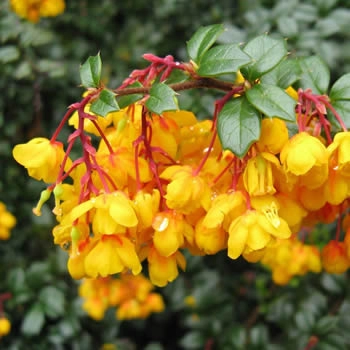
Pruning Shrubs
The Most Read Shrubs to Prune
- How to Prune Hydrangeas
- How to Prune a Rose Bush
- How to Prune Azaleas
- How to Prune a Lilac Bush
- How to Prune Buddleias - Butterfly Bushes
- How to Prune Forsythia
- How to Prune Weigela
- How to Prune Hebe
- How to Prune Camellia

Pruning Trees and Climbers
The Most Read Trees to Prune
- How to Prune Apple Trees
- Pruning Plum Trees
- Pruning Cherry Trees
- Pruning Olive Trees
- How to Prune a Grape Vine
- Acer Pruning | Pruning Japanese Maple
- How to Prune a Fig Tree
- Pruning Peach Trees
- Pruning Pear Trees
- How to Prune a Plum Tree

